Menu
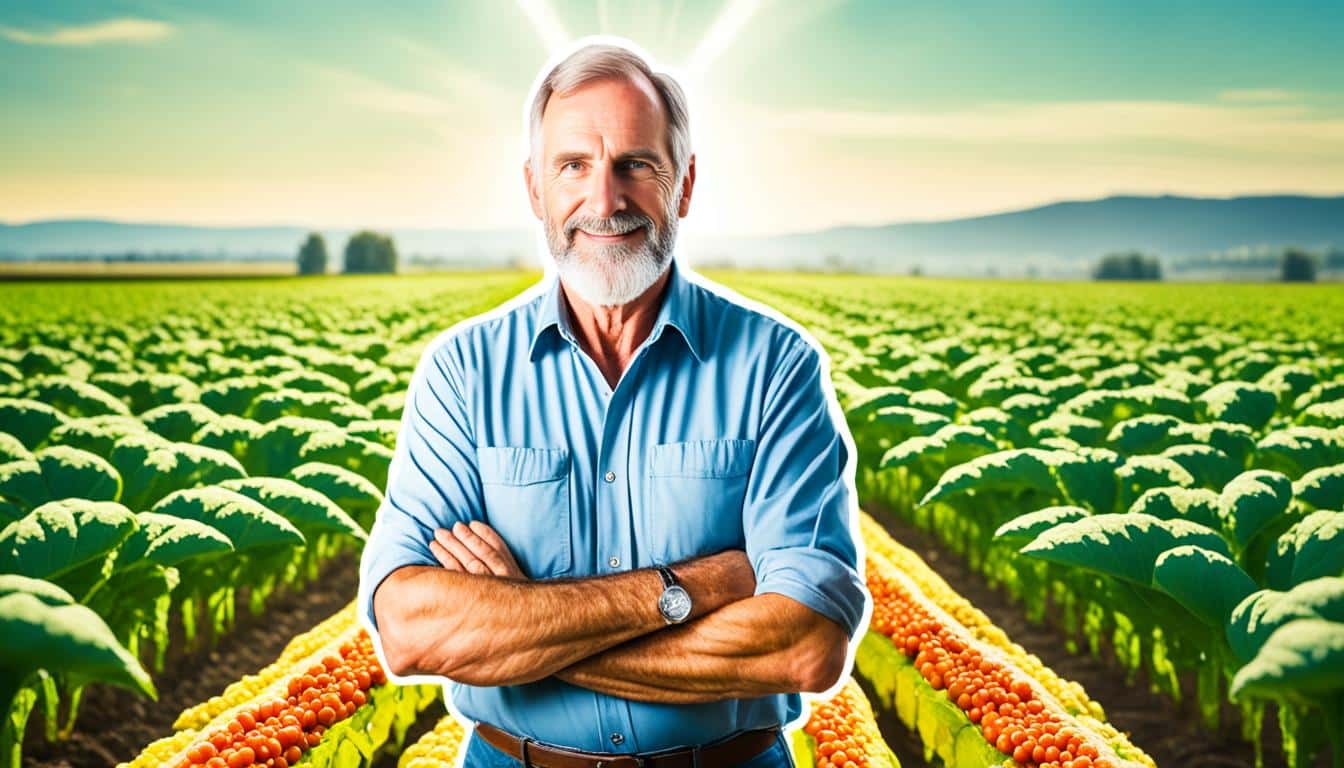
Did you know that vertical farms use up to 70% less water than traditional farms? This efficiency is thanks to agricultural biotechnology.
Agricultural biotechnology is changing the game for small-scale agriculture. It allows for the production of food, medicine, and more in a way that’s good for the planet. The global greenhouse market makes almost US $350 billion in vegetables each year. So, using biotech is really important now.
With new techniques like cheap DNA sequencing, we’re getting better pesticides, eco-friendly fertilisers, and plants that can handle the weather. But making these things is hard and costs a lot of money. The government doesn’t give as much to this area as it does to defense or health. However, President Biden is trying to help by offering more money for biotech research on farms.
Although biotech is great for small farms, using it everywhere is tricky. There are rules to follow and not everyone talks to each other well. But, these issues can be solved if everyone works together.
Agricultural biotechnology has changed farming dramatically. It introduced new ways to solve old issues. Through methods like genetic modification, crops grow better and resist diseases. This makes farming more efficient and eco-friendly.
The USDA helps make sure biotech farming is safe. It checks on biotech use by doing surveys and setting rules. In the US, most corn, cotton, and soybeans are biotechnologically improved. This has cut down on harmful pesticides and made food better.
Biotechnology is useful for many things in farming. It helps crops fight off bugs and weeds. For example, cotton that kills insects and soybeans that are not harmed by weed killers are common. These crops are checked by the FDA and EPA to be safe to eat and good for the environment.
Let’s look at some of the special ways biotechnology helps farming:
| Crops | Attribute | Impact |
|---|---|---|
| Bt Corn | Insect Resistance | Reduced pesticide usage |
| Glyphosate-resistant Soybeans | Herbicide Tolerance | Efficient weed control |
| Papaya | Disease Resistance | Fights ringspot virus |
Biotechnology is key in solving today’s farming problems. By using new techniques and technologies, we can have a farming that’s both sustainable and meets the world’s food needs well.
Sustainability is key for the future of farming. Nowadays, small farm technologies are changing how we farm. They help save resources and reduce harm to the environment. These tools are especially helpful for small-scale farmers around the world. Even though these farmers face big challenges, they provide a large part of the world’s food. This makes it very important for them to use these new technologies.
Biotechnology is crucial for making farming kinder to the planet. It brings in new ways to grow food that use less harmful methods. For example, a technique called precision agriculture lets farmers use water, fertilisers, and pesticides more carefully. This saves resources and protects the environment. It’s especially helpful for small farmers in places that face tough weather. It can help them grow more food and fight off the effects of climate change.
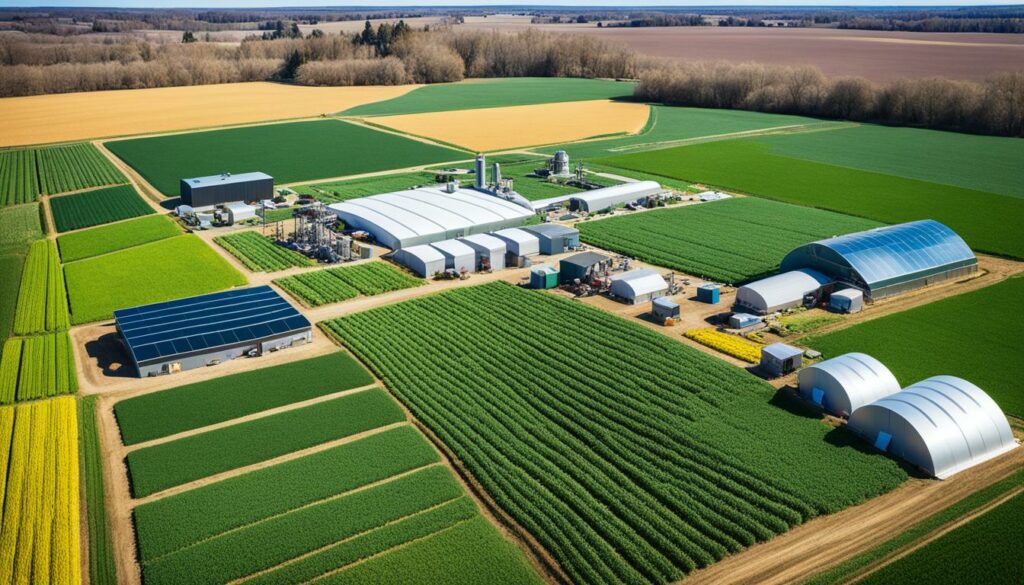
There are many ways that new farming technologies can help small farms:
It’s important for governments to help fund these new farming tools and make them easy to get. Over half of the world’s farmland is getting less productive. This is causing us to lose a lot of food. Using these new technologies is crucial to changing this. By making it easier to use such tools, we can protect the environment and grow enough food for the future.
| Key Area | Data |
|---|---|
| Smallholder Farmer Contribution to Global Food Production | One-Third |
| Climate Finance Received by Smallholder Farmers | 1.7% |
| Public Sector Contribution to Climate Finance for Small-Scale Agriculture | 95% |
| Global Agricultural Land Degraded | Over 50% |
| Productivity Losses Due to Land Degradation Annually | USD 400 Billion |
| Projected Increase in Agricultural Production by 2050 | 60% |
| Contribution of Food Production to Global Greenhouse Gas Emissions | More than a Third |
Biotechnology is changing the game for small farms. It offers tools that help with limited resources and size challenges. With biotech tools for small farms, farmers can boost both productivity and help the planet. For example, they can use special seeds that make crops better at fighting bugs and handling less water.
In 2012, the U.S. saw a big jump in using biotechnology for crops. It was used a lot in corn, cotton, and soybeans, showing a move towards wider use on small farms.
One key advantage of biotechnology is using less man-made bug sprays. This saves the environment and money for farmers. Plants that can handle more weed killer let farmers use less harmful chemicals, keeping wildlife and people safe.
Also, using fancy tools to check on soil and crops closely is a big help. This careful look helps use resources better, cutting waste and growing more food. By using these tools, small farms get more efficient quickly.
Choosing the right biotechnology brings big benefits, like:
| Key Biotech Crops | Adoption Rate (2012) |
|---|---|
| Corn | 88% |
| Cotton | 94% |
| Soybeans | 93% |
The U.S. Department of Agriculture (USDA), with others like the Environmental Protection Agency (EPA) and Food and Drug Administration (FDA), watches biotechnology closely. They make sure special crops are safe to eat and good for the land. This helps small farmers trust and use these tools more.
In the end, adopting biotech tools for small farms brings a brighter future for farming. It makes farms more efficient and able to face challenges, showing a sustainable way forward.
In the world of farming, biotechnology is making big changes. These new practices help farmers use the land better and grow more food. By making farming smarter and greener, we can care for the Earth while feeding more people.
Agricultural innovation is at its peak with precision agriculture. It uses advanced technology to know exactly what each plant needs. By applying just the right amount of fertilisers, pesticides, and water, it cuts waste and boosts growth. This kind of farming is becoming very popular, and it’s estimated to be worth $43.4 billion by 2025.
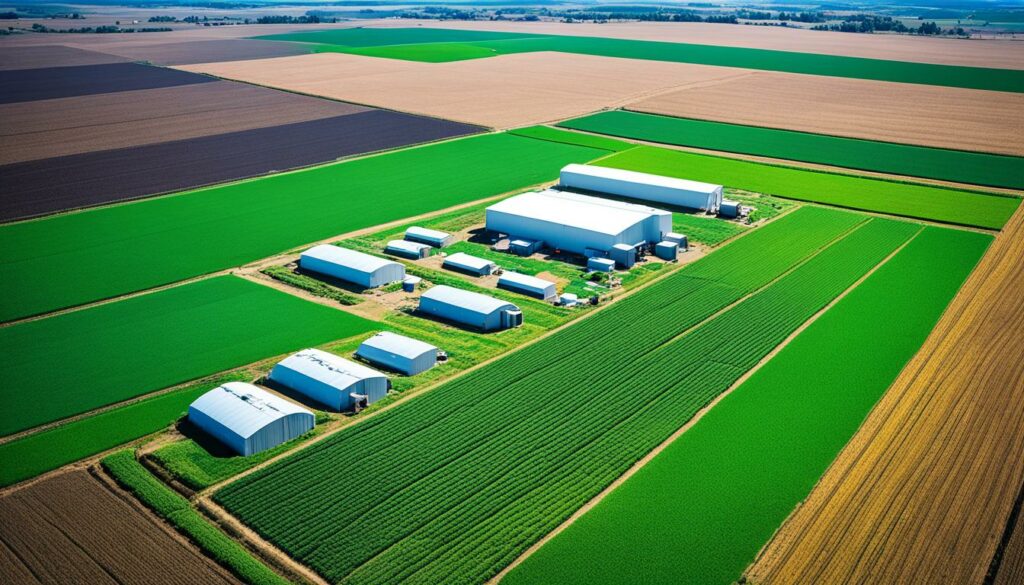
One part of precision farming is indoor vertical farming. It uses less water and space than traditional farms. This is because crops are stacked on top of each other. It’s not just about saving water; it’s also about using space efficiently. Machines like RTK technology help by guiding farm vehicles precisely. This means healthier soil and happier plants.
| Innovative Practice | Benefit |
|---|---|
| Indoor Vertical Farming | Uses up to 70% less water, reduces land requirements |
| RTK Technology | Offers centimeter-level accuracy, improves soil health |
| Farm Automation | Increases yields, reduces labour time, improves resource management |
GMOs are a big part of modern agricultural innovation. They are plants or animals changed to have special traits like fighting off pests. These changes make crops grow better in tough conditions and help feed more people around the world.
Big companies like Bayer, Corteva, and Monsanto are leaders in GMO farming. They’ve created seeds that need less chemical help and produce more food. For example, Monsanto’s Roundup Ready seeds are strong against a common weed killer. This discovery has been really important in managing weeds.
But GMOs do more than just fight off pests. They can also make food more nutritious, like Golden Rice. This special rice helps prevent vitamin A deficiency in poorer places. And new technologies like CRISPR are making GMOs even more useful. They’re pushing the boundaries of farming towards a future of better food for everyone.
Small farms today are adopting high-tech tools to produce more and sustain the environment. The blend of CRISPR, gene editing, and drone technology is changing the game. It allows farmers to tackle old problems and run their farms better.
CRISPR and gene editing are making a big difference in farming. They let us change the DNA of plants very precisely, leading to better crops. For example, crops can become able to fight pests, survive droughts better, and have more nutrients.
This means small farms can produce more food that’s healthier, helping feed the world. It’s a big step towards meeting the needs of a growing population.
While gene editing is not new, CRISPR is making it easier and cheaper for small farms to use. These technologies can lessen the need for chemicals and help the environment. They’re quickly becoming key tools in farming.
Drone technology is another game-changer for farming. Drones offer a unique view from above, giving farmers important information. This info helps them look after their crops better, by spotting problems early and reacting quickly.
But drones are more than just flying cameras. They can take pictures in different light and see how plants are doing. This helps farmers make smart choices, leading to more food with less waste and harm to the environment.
| Technology | Advantages | Impact on Small Farms |
|---|---|---|
| CRISPR and Gene Editing | Precise genetic modifications, pest resistance, climate resilience | Enhanced yields, reduced input costs, sustainable practices |
| Drone Technology | Real-time aerial imagery, improved monitoring, precise input application | Better resource management, proactive decision-making, optimised crop health |
Using technologies like CRISPR, gene editing, and drones can really boost small farms. These advances help farmers grow more food and protect the planet. They’re key in creating a stronger, sustainable future for farming.
Implementing biotech solutions is not easy, thanks to tough rules. These rules are different in each place, making it hard for small firms to get the go-ahead for new tech. The process becomes even harder in areas with weak rules, as getting approval there takes a long time.
The costs of R&D are also very high. It takes a lot of time and money to come up with new biotech ideas. Since these costs are high, many small companies just can’t start. This stops them from joining the market with their new products. Still, these new technologies bring big benefits. For example, some products help farmers use less fertiliser without cutting their crop’s value. There are products that can reduce fertiliser use by 25% without losing any harvest.
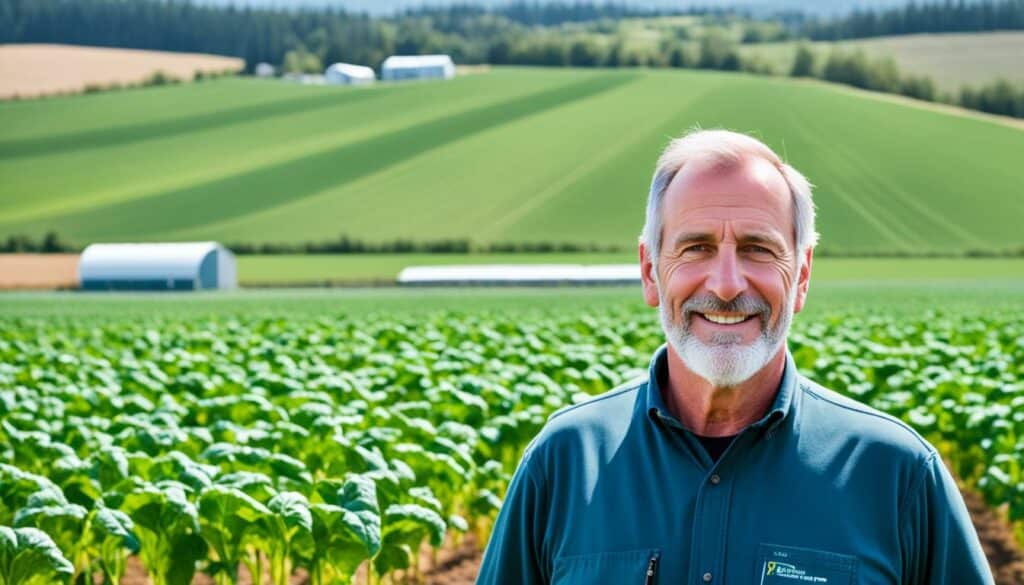
Not everybody knows how to use these new techs, either. For example, some farmers in poorer countries don’t have the info they need. They need to learn how to use biotech properly. That’s why there should be good programs and services to help teach them.
Different areas have different needs when it comes to biotech. For example, Africa needs special biotech to make food more secure. But, some of this tech, like crops that resist weed killers, is not widely used in Africa and South Asia. There are many reasons for this, including the cost and problems of adapting the tech. People are also worried about the risks of using this new tech, like the risk of allergies or harm to the environment.
By working together with local people, like farmers and leaders, we can solve these issues. To make biotech work well, we need a plan that looks at the local farming, the costs, and follows all the rules properly. This way, even small farms can enjoy the benefits of new biotechnologies.
Both government backing and private funds are key in advancing agricultural biotechnology. Their combined support helps move the sector forward. This support helps in filling the critical gaps in research and development (R&D).
Government aid is crucial for making lasting progress in agricultural biotechnology. For instance, the USDA has given over 8,400 microloans to new farmers since 2013. This shows how targeted funding can support new initiatives. Also, the Agriculture and Food Research Initiative (AFRI) helps small farmers make better decisions.
Still, there are funding challenges. The NIH had over 16 times more in R&D budget in 2022 than the USDA. This big gap shows that agricultural biotech research might not get enough funds. Even with a $50 million yearly budget, AgARDA only got $2 million from 2019 to 2023. This is often the case with agricultural biotechnology research funds.
Private sector money is very important for the growth of agricultural biotechnology. Companies like Fall Line Capital have helped a lot with funding. They support new businesses working on things like biopesticides and better farm equipment. Funding from venture capital (VC) firms has also increased in recent years for agtech.
One big challenge for new agtech companies is reaching out to farmers. This is hard because farmers’ needs are so different. Many startups need “bridge funding” to help them get through their early stages. Another problem is that farmers might not want to use new technology because of past bad experiences or they may not understand them. Overcoming these challenges needs everyone to work together towards a clear plan and to build trust.
Both government help and private investment are important in growing agricultural biotechnology. With good plans and enough finances, major improvements can be made. This helps in bringing more innovation and sustainability to small farms.
In the world of farm biotechnology, some success stories really shine. They show us what’s possible for small farms. Take the work done by GreenLight and Fall Line Capital, for example. Their efforts in RNAi technology and smart investments are truly impressive.
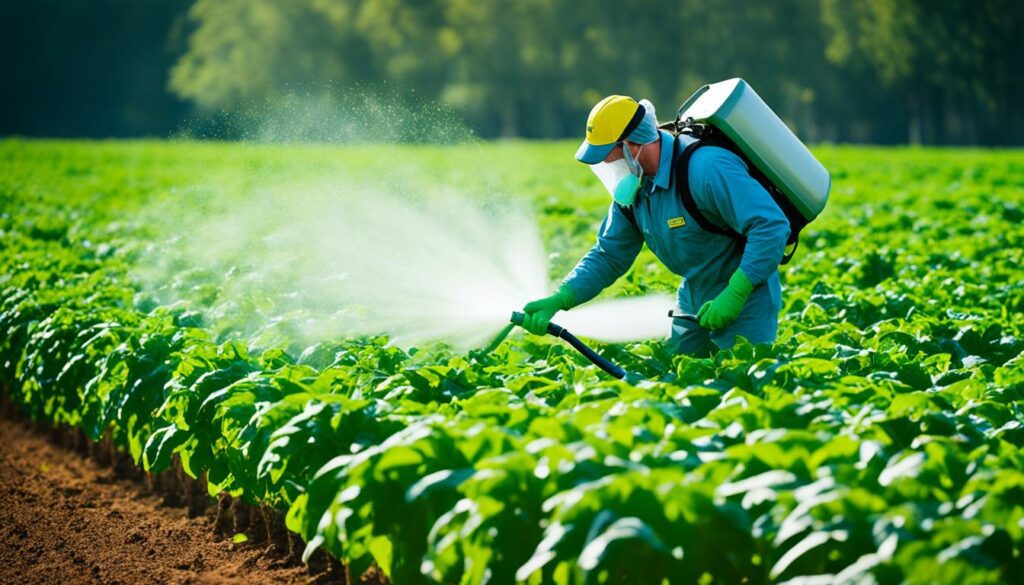
GreenLight’s RNAi biopesticide is changing how we fight pests. It targets the potato beetle with great accuracy. By silencing key genes in the beetle, it kills them off without hurting other bugs. This safe and smart approach is good for the environment and effective for small farms.
Investing in farm tech is crucial, and Fall Line Capital knows this well. They back start-ups that make amazing products like GreenLight’s biopesticide. These moves help small farms get new tools, making them more productive and eco-friendly.
Important case studies from places like India and China prove how biotech boosts farming. In India, a special type of pearl millet now grows on a huge area, helping over two million farmers. A unique rice in India’s flood zones also increased rice farming success. In China, a special carp is now on many farms, making up half the country’s carp supply.
| Country | Crop/Livestock | Outcome |
|---|---|---|
| India | HHB 67 Improved Pearl Millet | 900,000 hectares cultivated, benefiting around 2 million people |
| India | Swarna-Sub1 Rice | Produced 1-3 tonnes more rice per hectare in flood-affected areas |
| China | Jian Carp | Grown on about 160,000 farms, accounting for over 50% of total carp production |
“Over 840 million people suffered from chronic hunger in 2011-2013, necessitating the adoption of innovative biotechnologies to enhance food security and sustainability.”
Projects like GreenLight’s biopesticide and the support from Fall Line Capital are key. They help small farms do their part in battling hunger and improving farming methods.
Integrating biotech into farming needs a specific plan. It must look at what’s around, the plants grown, and what’s available. This approach is key in India’s farming, where biotech is a big part, boosting the country’s growth (Business Standard, 2013).
There’s been a stop in making more food, but the need is growing. This happened as land got lost and the weather changed a lot. To fix this, farming needs to mix science, farming, making stuff, money, and helping communities. Zero Budget Natural Farming is one way. Over 50 lakh farmers use these friendly methods. They do things like take care of the soil, use less water, plant different things together, and put a layer on top.
To feed more people by 2050, farming must get better using biotechnology. This matches the hard task of being new and still making sense. Some argue about using nature or science in farming. Purnhagen and Wesseler (2021) talk about this.
Putting biotech in farming means using things like changing genes to help crops grow better. This has made a big difference in how much food we get since 2000. Even though some worry about it linked to big, industrial farming and lots of chemicals, using biotech with natural methods looks hopeful. It might help deal with not enough space to grow things, not enough resources, and needing less man-made stuff on the fields.
Think about how great biotech can be for growing more food. While maize, rice, wheat, and soybean crops get better a little bit each year, it’s not enough. We need the food we grow to go up faster. So, adding biotech in our usual ways of farming is key. It can help against the trouble of making sure there’s enough food for everyone.
Using biotech smartly in farming helps a lot. It can give more food, make crops stronger against bugs or the weather, and offer food that’s really good for you. This is all while keeping the world around us healthy.
| Aspect | Traditional Farming | Biotechnology-Enhanced Farming |
|---|---|---|
| Resource Utilisation | Often resource-intensive, reliance on synthetic inputs | Efficient use of inputs, reduced need for synthetic fertisers |
| Pest and Disease Control | High dependence on chemical pesticides | Genetically modified crops providing inherent resistance |
| Crop Productivity | Yield increases often limited by traditional practices | Significant yield enhancement through genetic improvements |
| Environmental Impact | Potential soil degradation, lower biodiversity | Preservation of soil health, enhanced biodiversity |
| Sustainability | Focus on short-term gain | Long-term sustainable practices |
With changing climate, making crops that can survive tougher conditions is key. Biotechnology provides many tools to make plants that withstand extreme heat, unusual rain, and other stress. These methods improve plant growth, making farming more sustainable.
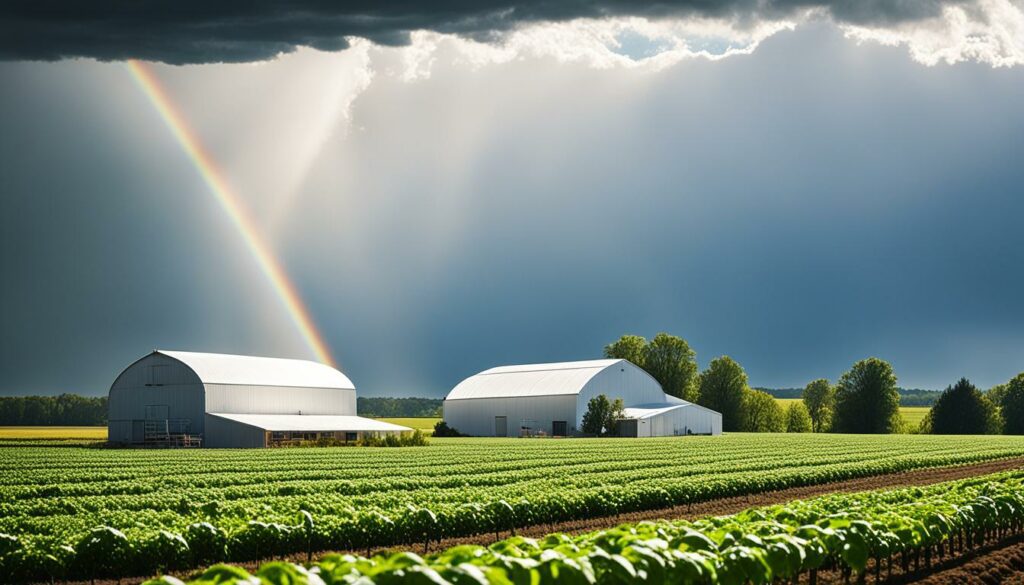
Biotechnology is crucial for ensuring our food sources survive climate challenges. For example, some wheat varieties are now better in quality and nutrients by 65% (Baik et al., 2009). And, perennial rice gives 30% more grain than the usual type (Zhang et al., 2023). Adding genes from wild plants to rapeseed made it 15% more resistant to a common disease (Mei et al., 2020).
Using focused methods, biotechnology strengthens crops against pests and diseases. It produced chickpea plants that resist a common fungus by 100% (Bharadwaj et al., 2022). This not just meets a specific need but also keeps harvests stable. By fighting off diseases better, crop loss could drop by 30% (Bigini et al., 2021), a major win for farmers. Plus, helping identify plant genders has improved results for 50% of female kiwifruit growers (Guo et al., 2023), highlighting how biotech can help everyone.
Biotech solutions are key for today’s farming challenges, making crops stronger against various threats and boosting their output.
To get small farmers to use biotechnology, we need to teach them well. Teaching should include both theory and hands-on practice. This will make sure they use new biotech methods wisely.
Teaching farmers about biotechnology is crucial. The lessons should fit the challenges they face, like low funds or poor infrastructure. This is especially true in places still developing. Lessons must look at the good and bad of biotech, focusing on how it helps in real life, especially for local crops.
Statistics reveal that more than 80% of the world’s half a billion farms operate on less than two hectares of land. These small farms produce approximately 80% of the food in Asia and sub-Saharan Africa, underscoring the importance of equipping small-scale farmers with biotech knowledge.
Working together is key for spreading biotech use. This means joining farmers, scientists, and leaders in discussions and sharing info, either in person or online. By starting projects together and using technology for things like choosing seeds, these groups can support each other well. This approach is crucial where traditional farming methods need updating.
| Factors | Challenges | Strategies |
|---|---|---|
| Herbicide-Tolerant Crops | Variety Appropriateness | Localised Crop Development |
| Labour Dynamics | Displacing Wage Labour | Diversified Labour Strategies |
| Affordability | Cost of Biotech Products | Subsidies and Support |
| Research Priorities | Limited Resources | Governmental Guidance |
To make progress, everyone involved must plan well. Because leaders often don’t know where to focus, education and networking efforts need to make sure they are informed. With good teamwork, using biotech can be more effective, ensuring it brings widespread and lasting benefits.
Farmers and scientists are merging to uplift the world’s food security. Yet, this biotechnological revolution sparks environmental and ethical debates. From religious views to global cultures, the ethics of gene editing shake traditional beliefs about life. These concerns date back to 2000, highlighting the clash between biotech and ethical norms.
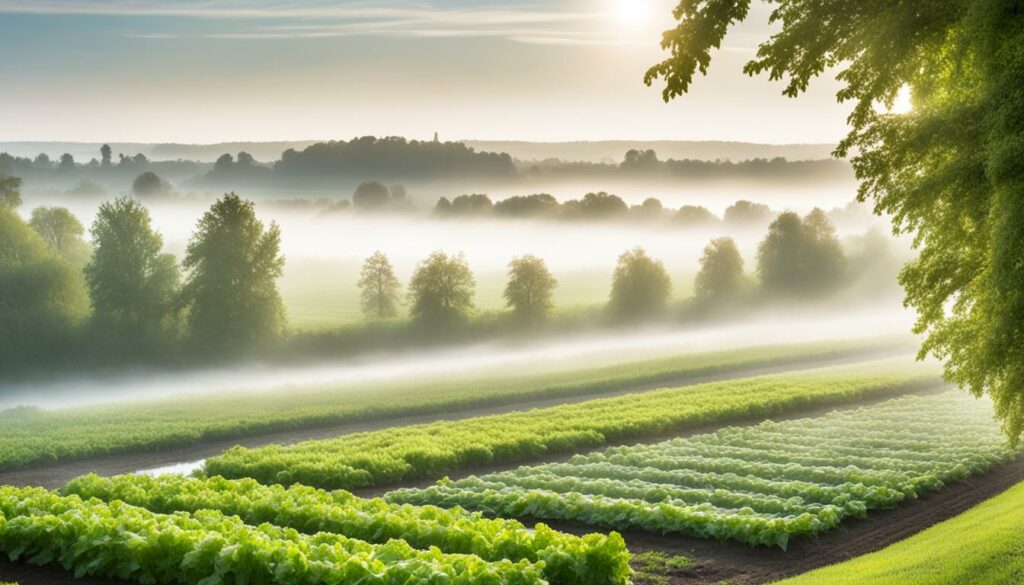
When we look at agricultural biotech, saving the environment and ensuring food safety stand out. Governments must weigh the ethical treatment of creatures against scientific advances. They aim to ensure modified organisms don’t harm nature.
On another front, farmers and community rights emerge as key topics. The rise of the Precautionary Principle shows a way to dodge the worst impacts of biotech. It also spotlights the importance of consumer rights through labels and informed choice.
Discussing openly with the public is critical. Detractors fear that mass production and big companies could spell trouble. To build faith in these advances, open talks around risks and benefits are essential.
Mutually, we must address the social and economic sway of biotech. This includes backing up small-scale farmers. Done right, these efforts boost food production, make food healthier, and benefit poorer countries.
| Key Ethical Issues | Description |
|---|---|
| Intrinsic Ethical Issues | Concerns arising from the use of genetic technology itself |
| Specific Ethical Issues | Concerns related to biotechnology applications, such as animal welfare and ecosystem risks |
| Environmental Ethics | Risks to ecosystems and food safety |
| Impact on Farming Communities | Issues like farm bankruptcies and power shifts in decision-making |
| Precautionary Principle | Approach to address uncertainties in biotechnology applications |
Ultimately, a balanced and ethical path in agricultural biotech is key. It ensures a bright and fair future for all.
The future is bright for small farms, thanks to biotech. It’s all about more crops, greener ways, and facing challenges head-on. Let’s explore the latest trends and key suggestions for what’s ahead.
Future biotech innovations offer hope for small farms. We’re seeing crops that can handle stress and bugs better, thanks to science. Also, we’re learning how to improve soil, though at a slower pace.
The U.S. is leading the way in agricultural biotechnology innovation. Early rules helped boost special crops, making the U.S. shine in the global tech race. Plus, quick checks on food safety have made it easier for new tech to reach farms, showing rules are key for progress.
To get the most from these emerging agricultural technologies, we need smart rules. Looking back, some places have had a hard time keeping up. The EU is updating its rules to match new science better.
The White House says let’s focus on possible risks, not just on how new a farm tool is. This could keep us safe and moving forward, helping both farmers and everyone else.
There’s also a big gap in money that goes to different kinds of research. For example, the NIH has way more cash than the USDA. Projects like AgARDA don’t get enough money, showing we need to invest more in farm research.
| Organisation | Authorised Funding FY2022 | Actual Funding Received |
|---|---|---|
| NIH | $1 billion | $1.5 billion |
| USDA | $50 million | $2 million |
To really make the future of farming better, let’s teach everyone more about biofarming. Helping farmers learn new things and work together can make a big difference.
Biotechnology is changing the game for small farms. It’s bringing a new era of growth in agriculture. This tech helps farms be more sustainable and ensures there’s enough food. It also keeps small farmers in business. Did you know, more than half of the food you see in shops comes from biotech crops?
In the US, such crops make up a big part of farming. About one-third of corn and most soybeans and cotton are made this way. There are twelve types of such crops, including corn, soybeans, and potatoes. A big win is the use of “Bt” crops and soybeans that resist a weed killer. These help crops do better and produce more food.
But, there’s more work to do, especially in poorer areas. Places like Africa and South Asia need crops that can survive there. They have unique farming styles and available resources. Yet, important food like cassavas and yams often get overlooked by tech companies. To help, we need to make biotech more available and affordable to these small farmers. Key to this is making sure the right tech gets to those who need it most.
In short, using biotech in small farming is full of promise. But, we need a plan that brings together many aspects. This includes laws that help, money, learning, and being fair. By focusing on these areas, we can make the most of what biotech offers. This could lead to a farm future that’s not just strong but also looks after the planet.
Agricultural biotechnology improves plants and animals with science. It makes them produce more and use resources better. This can help the environment too.
For small farms, biotechnology provides ways to increase what they grow. It makes crops tougher against pests and the weather.
Small farms can also use special tools to check their soil and plants. This helps them use water and nutrients wisely.
Precision farming and using natural pesticides are good examples. These methods help farmers do more with less. They reduce harm to the environment.
Small farms find it hard to deal with rules and high costs. They sometimes lack the knowledge they need. This means they can’t make the most of new technologies as much as big farms can.
Precision farming makes farming very exact. By using data, it helps farmers grow more food. It means farmers use water, fertilisers, and pesticides just where they’re needed. This saves resources and the environment.
GMOs make crops stronger against bugs and improve their nutrition. This makes farming more sustainable. It also cuts back on harmful chemicals.
CRISPR and gene editing are big for small farms. They let farmers change plant genes. This can make crops need less water, fight pests better, and grow more.
Drones fly over farms taking pictures. They help farmers see how well their crops are doing. This information helps farmers water and feed plants better. Drones make farming management smarter and easier.
Money from governments and businesses is vital for farming science. It pays for new ideas and helps get technology to farmers. Without funding, progress would slow down.
GreenLight’s biopesticide, which targets harmful potato beetles, is a great success. It’s safe and toxin-free. This product helps small farmers keep pests away without harming the environment.
To mix biotech into their farms, small farmers must adapt new technology to their needs. They should keep what works from traditional farming. This mix is the key to success.
Using biotech should consider its impact on nature and people. It’s important to look at how it affects the environment and small farmers. This ensures it’s used in a good way.
Educating farmers and helping them work together is crucial. They need to learn about new technology and its real life benefits. This fights false information and worries.
Soon, small farms could have crops that do better in bad weather and fight off pests. These innovations will help farms produce more food and withstand changing climates.